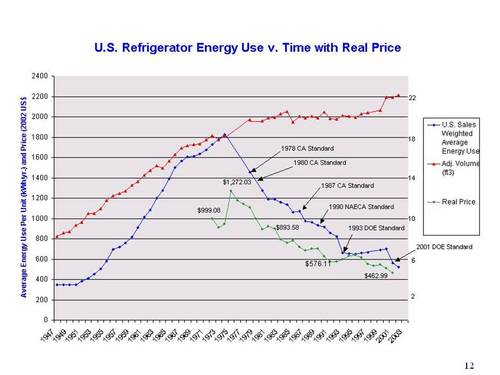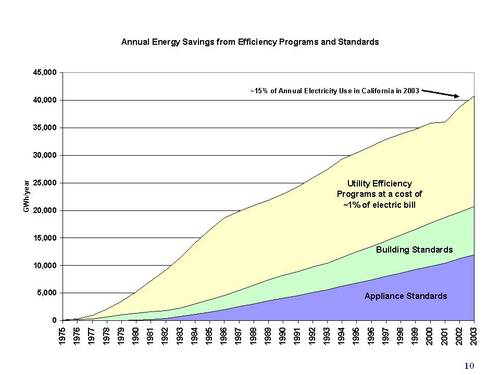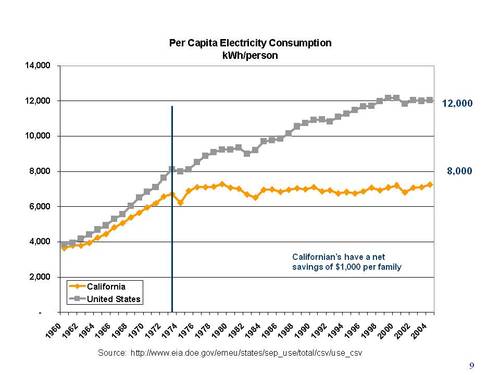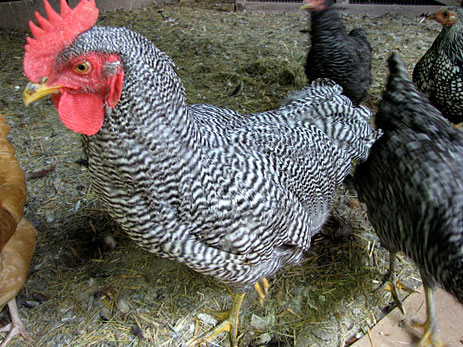Cross-posted from the Natural Resources Defense Council.
In “The Efficiency Dilemma,” The New Yorker (Dec. 20, 2010) [$ubreq], David Owen revives a discredited 19th century article on economics to posit that the increasing efficiency of household products such as refrigerators and air conditioners is responsible for a range of problems, including everything from food waste to America’s culture of excess. Owen argues (apparently seriously) that by allowing consumers to save money that would otherwise go to high and wasted energy bills, efficient appliances have caused Americans to abandon the simple life.
Owen — whose expertise lies in the unrelated field of golfing (I’m not making this up), has unfortunately cobbled together this thesis without the benefit of facts or data. In the real world, efficient appliances (and the laws and policies that make them increasingly efficient) play a major role in reducing household energy usage, slashing energy bills for those consumers who can least afford them, and avoiding the need to build new costly power plants. Sad to say, this article — however well-intentioned, is a great example of misguided pseudo-analysis that is based on rank speculation made worse by gross errors of fact.
The reality is that the increase in efficiency of appliances is a huge success story for all consumers who benefit from the savings these products provide. Refrigerator energy use was growing with a trend that would have resulted in electricity demand of about 175 GW by today; but with efficiency policies that level of power demand was cut to less than 15 GW. The difference, about 160 GW, compares to about 125 GW provided by the entire nuclear power fleet in the United States, or to 400 large coal plants that were expected to be needed but now are not.
Owen, however, blames a host of evils on efficiency, but fails to back up his accusations with facts. Owen starts by conceding that serious energy analysis of rebound effects shows them to be “comparatively trivial.” People who insulate their houses don’t absorb all the savings by sweltering through the winter, and buyers of efficient refrigerators don’t start leaving the door open gratuitously. But after admitting that the serious studies show rebound effects to be small and getting smaller over time, he does nothing to address the finding of the studies but instead starts writing a fairy-tale story of how efficient refrigerators don’t really save energy because somehow efficiency is responsible for the growing size of refrigerators, the increasing extent of refrigeration, and even the growing girth of Americans. The author notes how the size and feature offerings of refrigerators increased rapidly from 1954 until recently, and then, with out-of-the blue imagination, tries to link this to efficiency increases.
The facts stubbornly contradict this hypothesis, however. Figure 1 shows that trend in refrigerator size and energy use. What leaps out from the graph is that the big, fast increase in size (the red line) occurred WHEN EFFICIENCY WAS DECLINING. When efficiency began to improve, after 1972, the trend toward increasing size SLOWED DOWN. This is positive evidence that the rebound hypothesis is false, at least for refrigerators, Owen’s first example of choice. The growth in energy services in home refrigerators evidently has at best no relationship to efficiency, or even worse for this author’s point, is INVERSELY CORRELATED: the evidence suggests that greater efficiency implies more satiation with energy services.

Owen then refers to the great increase in refrigeration in stores, a phenomenon he asserts but does not demonstrate to be true, somehow trying to relate it to the efficiency of home refrigerators. A more plausible speculation is that it had to do with the trend towards suburban sprawl, where the absence of retail food stores within walking distance of homes leads to people making longer trips to the grocery store at less frequency and (necessarily) picking up more food each time. Even this explanation does not necessarily imply that the shelf area that is refrigerated must, or did, increase. And when Owen refers to the kitchen of a friend of his with multiple refrigerators and freezers, he apparently is unaware of the fact that there were already 15 percent more home refrigerators than homes in 1973 when refrigerator efficiency was at its low point. The number is hardly different today.
The speculation then extends to air conditioners. Did air conditioning get much more common after 1960 because the cost of cool air went down? The facts are that the EFFICIENCY of air conditioners was not regulated until 1978 and even then only at the state level. National standards for air conditioners did not take effect until 1992. So to support his hypothesis, the author would also have to show that air conditioners’ market share started to rise in 1992, which he doesn’t do. In large part because it is not true.
Instead, he uses cooling as an example of how demand for energy services can grow. But this is undisputed, and is included in every forecast of energy use with or without efficiency policies. Efficiency does not mean restraining energy services growth. It means using less for the same amount of service. The author is confusing this trend with the sometimes-on sometimes-off trend towards more efficiency, and claiming that more efficiency INDUCES more demand for energy services. Again, this is what the serious studies were addressing when they found the effect to be “comparatively trivial.”
The problem is that he has not presented any evidence that this is happening in the real world: all of the examples he talks about (at great length) are devoid of any mention of how one could relate the energy service demand growth to efficiency as opposed to other economic factors. He does not even say HOW one could do so, much less present evidence that someone has really done so.
The clearest test, though, of the author’s hypothesis is whether an economy that embarks seriously on efficiency policy really can cut its overall energy use. Because without question, if the author’s thesis has any plausibility at all, the answer has to be “no”; or at least “not nearly as much as predicted.”
Fortunately for the cause of economic truth, we have such an experiment. California embarked on a broad set of policy reforms to encourage efficiency and promote renewable energy in 1974.
Figure 2 shows the expected results: the ones Owen claims should not show up in overall consumption data. These are the projected savings from energy efficiency programs, derived year by year in real time by the California Energy Commission.

Figure 3 shows the realized results for the whole California economy. As you can see, the reduction in electricity use compared to the rest of the US is not smaller than the projections, it is bigger. Figure 2 shows efficiency programs to have resulted in a 15 percent reduction in usage, but Figure 3 shows an actual reduction of 40 percent compared to the rest of the country (which itself saw reductions in electricity use due to efficien
cy).

So if anything is rebounding, it is the influence of energy efficiency policies-they are causing a whole economy (California would be the 8th largest national economy in the world if it were a nation) to save much more than one would expect. California is not the only example of a state or country promoting efficiency through policy and then showing divergent usage trends from its neighbors and thus demonstrating that energy really is saved. Perhaps this is why the serious studies to which Owens referred found that the economy-wide rebound effect is trivially small.
And more detailed versions of this graph also refute Owen’s attempt to claim that energy use really would be increasing if we also consider the energy use embedded in things we used to manufacture domestically but now import. The detailed version looks separately at residential, commercial, and industrial uses of electricity in California compared to the rest of the nation. The graph looks just the same. So while one can still argue about how much different the industrial sector would look if we added in Chinese imports, clearly we are not importing buildings or the operation of our lights and appliances.
This is not inconsistent with theory. One of the biggest impediments to saving energy is that it is so small a fraction of GDP — the author suggests six percent. This is too small for people to pay much attention to. So not only do people ignore efficiency, absent policy, they ignore conservation as well. Thus we see stories like our own office’s experience with efficient lighting. When NRDC moved into a new space in San Francisco in about 1988, we negotiated with the landlord to pay for a much more efficient lighting system by agreeing to pay the extra up front but then reap the savings in utility bills compared to an agreed upon baseline every month. To determine savings, the landlord metered our lighting.
But the fact that we were paying for the lights, and the visible reminder that the lighting was special and efficient (it looked much better than inefficient building standard lighting) caused our staff to cut the hours of operation by over half compared to the baseline. We not only got the savings from efficiency, but they were redoubled by behavior changes, even though we did or said nothing to encourage this behavioral change.
Efficient appliances save energy, reduce energy bills and rates, avoid the need to build new power plants, and save Americans money. It’s really that simple.



